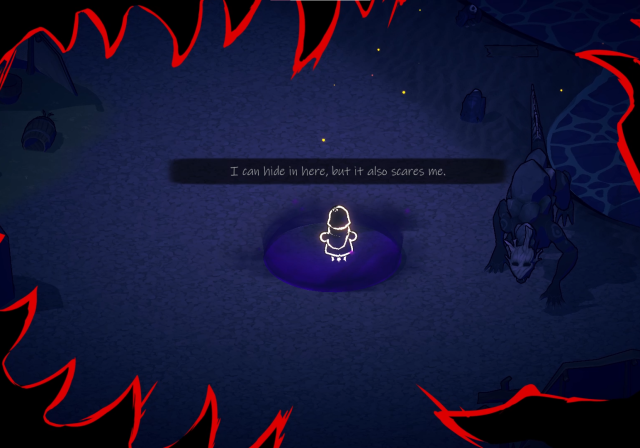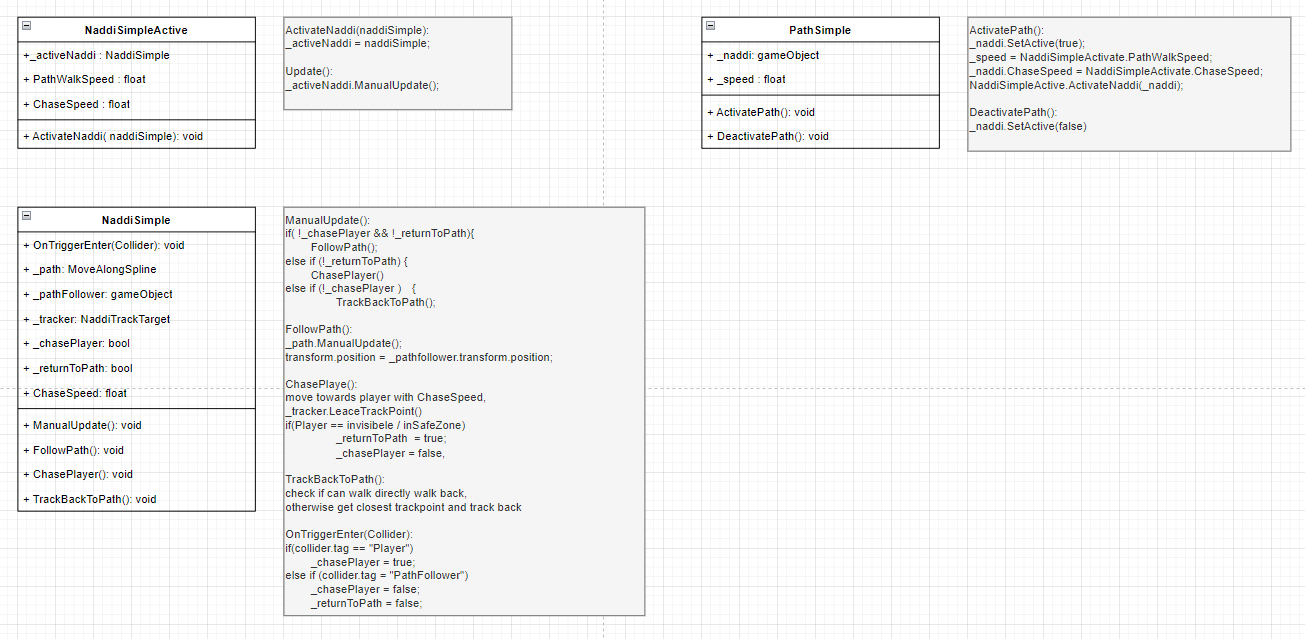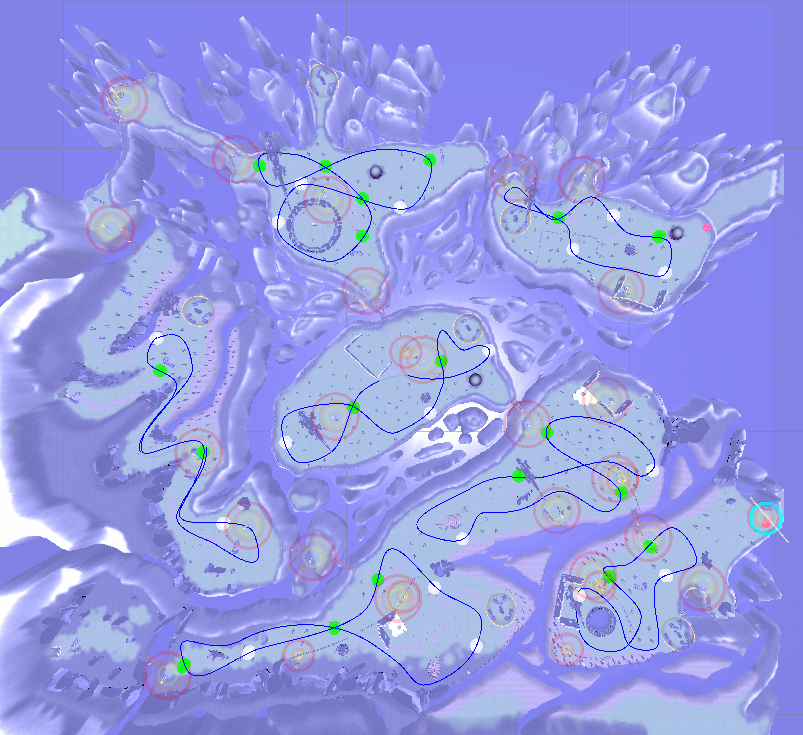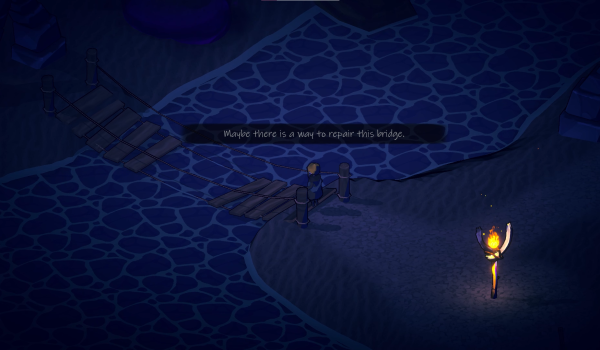Keyfacts:
Engine: Unity
Platform: PC (Windows)
Controls: Keyboard
Genre: Cozy Horror / Stealth
Perspective: Isometric
Setting: Island
Style: 3D stylized low poly
About the Game:
Waking up as a young child during a dark night, players need to find their way home as the current flood cuts off the regular route. Being scared in the dark, the kid’s decreasing sanity also decreases the sight range, forcing players to seek light and shed off some fear. Torches and abandoned campfires invited to take a break, while calming down, but the peace is limited: The Naddi, a mythological creature, roams the islands, ready to devour any human he might find. Even so shrines offer protection, players must navigate the unknown landscape, avoiding the monster’s perception. Dodging by hiding from his view, or making use of the dark shadows- which in turn increase the child’s fear- only helps so far: To cross to new shores, players must repair broken bridges with planks they have to find.
Not only do these noises alert the Naddi, the divergent pavements can increase the walking volume. This might startle the birdlike Utburdur, scattered across the map. The Naddi also gathers clues from his surroundings and can tell a human is present, as torches don’t light themselves.
As the players progress, they can make use of totems, engraved with runes, which serve as checkpoints, from which they can continue if they get caught by the Naddi.
For those tending to get lost, the child offers tip to progress further.





My tasks:
Perception system:
As the Naddi represents the only enemy, adjusting his perception of the world and player were crucial. Receiving clues by the player about their presence increases a so-called “Awareness” value, changing their behavior. It automatically deplete when no information about the player is perceived. Besides the usual sight and hearing, each containing three ranges of increasing impact, the Naddi also contained a nature-sense. As protector of the environment, his awareness rises when the player walks through bushes or tramples mushrooms.
Aside from the player himself, changes in environment get noticed by comparing their current stati against the last memorized one.



Behavior-design:
Since freely roaming the unconnected islands was not an option, a path-system was set up, teleporting the Naddi according to the player’s position to the fitting island.
To increase the challenge, difficulty and immersion, the Naddi also acts depending on different states, which correspond to the awareness level. For instance, he only pauses his patrols, if he’s just “suspicious” and inspect areas aside from the current path when “alert” or “aware”.


Trailer / gameplay footage:
Since the final presentation demanded trailer and gameplay footage, planning, filming and editing the videos was necessary. In collaboration with the lead designer, the material was recorded and the planned cuts executed, iterated and finalized.


Interactable elements:
As the player needed to manage their sanity, torches and safe-zones were designed. By activating those, the players‘ sanity increased- but could startle nearby Utburdur, which would alert the Naddi. Besides light and positive elements, the player was able to hide not only behind obstacles, but also in shadow-zones, which would increase the loss of sanity but render them invisible to the Naddis direct perception.
Playermovement:
The level contained different grounds, which resulted in differing step-sound-volume for the player. To keep control of the noise, they were able to switch between regular walking and running. Walking was more quiet, but much slower than the Naddi, while running made noise as one covers larger stretches with a speed comparable to Naddis.
Implement animation / sound:
As Naddi, Utburdur and Player needed to trigger different animations and sounds depending on the situation, the switching of those got handled in their related behavioral scripts.
Changed plans:
Milestones / production timeline:
Some hero features like the checkpoint system and player guidance via tooltips got implemented very late in the process. As they impacted the Naddis and Utburdurs behavior, testing became increasingly difficult. To reduce risks, both were reduced in complexity to detach them from each other. In the simplified versions, the Utburdur purely served a decorative and atmospheric purpose. The Naddis final behavior consisted of walking the active path, hunting the player if his awareness was maxed out or returning to his route, if he lost track of the player.


Level two:
As a game design hybrid, I was responsible for designing and setting up a second level. A clear requirement was the creation of an optical different biom, without majorly increasing the artist’s load by using current assets. Since level one takes place at the flooded beach on different tiny islands, level two takes place on the cliffs towards the inner land, divided by canyons and a few rivers. Instead of fishing huts and boats, abandoned farms, camps, carriages and ruins defined the different regions.
As the former mentioned changes became necessary, testing and polishing level two had to be cut completely due to prioritizing.






Critters:
We also intended, to underline the quiet environment and lack of humans with critters like crabs, mice and harmless birds. They should have had mostly decorational value, only triggering the Naddis nature sense of intended disturbance.
Player actions:
Besides the option to sneak and reduce noise further, players were intended to collect and throw stones, to distract the Naddi or startle the Utburdur or critters. Forced to inspect the area, Naddis movement would enable players to perform loud actions or cross tighter spots.
Story:
The current story of a child waking up after a day of fishing, during the darkest hours of the night, trying to find its way home, should have been expanded on. Besides the lore behind Naddi and Utburdur, the setting should have been represented via found pages of a journal or information the protagonist volunteered on encountering certain scenarios.








